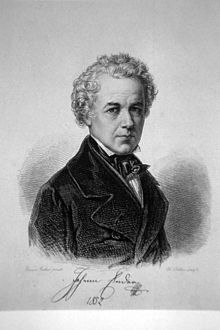Johann Ender

Johann Nepomuk Ender (born November 3, 1793 in Vienna ; † March 16, 1854 there ) was an Austrian portrait painter and copperplate engraver .
Life
Ender studied for several years at the Academy of Fine Arts in Vienna. On the occasion of an academy exhibition, Ender was able to make his debut with his work The Death of Marcus Aurelius and this was also awarded. Ender soon found his own style, but at the same time began to imitate the painting style of his contemporary Jean-Baptiste Isabey .
In 1818 Ender was invited by Count Stephan Széchényi to tour Greece and Italy with him . Ender agreed and brought back a large number of sketches and studies from this study trip, which later formed the basis for his oil paintings . This trip gave Ender contacts that later enabled him to stay at the Accademia di San Luca in Rome .
In 1826 Ender returned to Austria and settled in Vienna as a freelance artist. From 1829 to 1850 he taught as a professor at the Academy of Fine Arts. In his art now came to oil painting also engravings , but he earned most of his living expenses with portraits . According to the official art criticism of his best works is the crucifixion scene for the cross and Prince Eugene Chapel of St. Stephen's Cathedral in Vienna, an oriented on Italian Renaissance models large mural fresco, worked on the final 1850 to 1852.
The painter Johann Ender died at the age of 60 on March 16, 1854 in Vienna and was buried in the Catholic cemetery in Vienna Matzleinsdorf (today: Waldmüllerpark ).
His twin brother Thomas and his son Eduard were also painters. In 1922, the Endergasse in Vienna- Meidling (12th district) was named after the Ender family.
Works (excerpt)

- Archduke Karl with his children at the Weilburg in Baden near Vienna , 1832. Oil on canvas, 272.5 × 318.5 cm. Army History Museum , Vienna
- The death of Marcus Aurelius
- From darkness to light , 1831. Oil on canvas, 350 × 250 cm. Hungarian Academy of Sciences , Budapest
- Portrait of Count József Dessewffy , 1820. Oil on canvas, 26 × 20 cm. Historical Museum , Budapest
- Portrait of Count György Károlyic , 1830. Oil on canvas, 26 × 20.3 cm. Hungarian Academy of Sciences , Budapest
- Portrait of Ferenc Széchényi 1823. Oil on canvas, 318 × 220 cm. Hungarian National Museum , Budapest
- Portrait of Countess Selina Clam-Martinic, 1838. Oil on canvas, 70 × 90 cm. Burgmuseum Clam , Klam, Austria
literature
- Constantin von Wurzbach : Ender, Johann Nepomuk . In: Biographisches Lexikon des Kaiserthums Oesterreich . 4th part. Typogr.-literar.-artist publishing house. Establishment (L. C. Zamarski, C. Dittmarsch & Comp.), Vienna 1858, pp. 38–41 ( digitized version ).
- Heinrich Kábdebo: Ender, Johann . In: Allgemeine Deutsche Biographie (ADB). Volume 6, Duncker & Humblot, Leipzig 1877, p. 105 f.
- Ender Johann Nepomuk. In: Austrian Biographical Lexicon 1815–1950 (ÖBL). Volume 1, Verlag der Österreichischen Akademie der Wissenschaften, Vienna 1957, p. 247.
Web links
- Entry on Johann Ender in the Austria Forum (in the AEIOU Austria Lexicon )
- Literature by and about Johann Ender in the catalog of the German National Library
- Web Gallery of Art, image collection, virtual museum, searchable database of European fine arts (1100-1850)
Individual evidence
- ^ Manfried Rauchsteiner , Manfred Litscher: Das Heeresgeschichtliche Museum in Wien , Verlag Styria , Vienna 2000, ISBN 3-222-12834-0 , p. 43.
| personal data | |
|---|---|
| SURNAME | Ender, Johann |
| ALTERNATIVE NAMES | Ender, Johann Nepomuk |
| BRIEF DESCRIPTION | Austrian painter |
| DATE OF BIRTH | November 3, 1793 |
| PLACE OF BIRTH | Vienna |
| DATE OF DEATH | March 16, 1854 |
| Place of death | Vienna |

